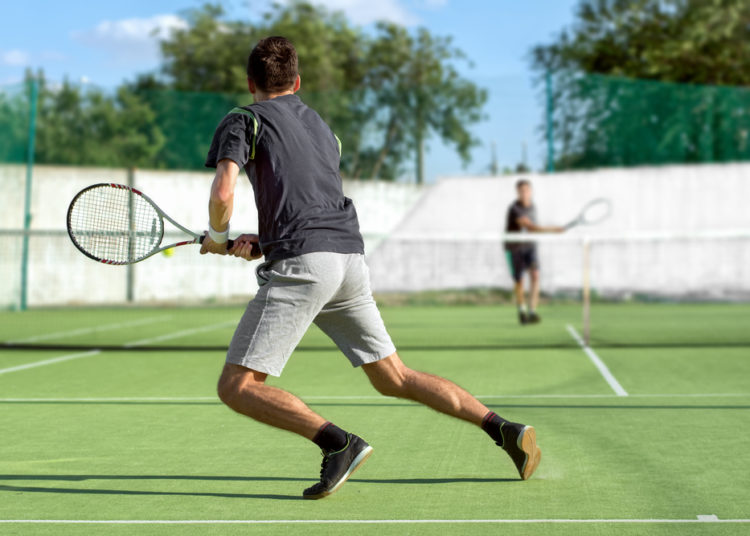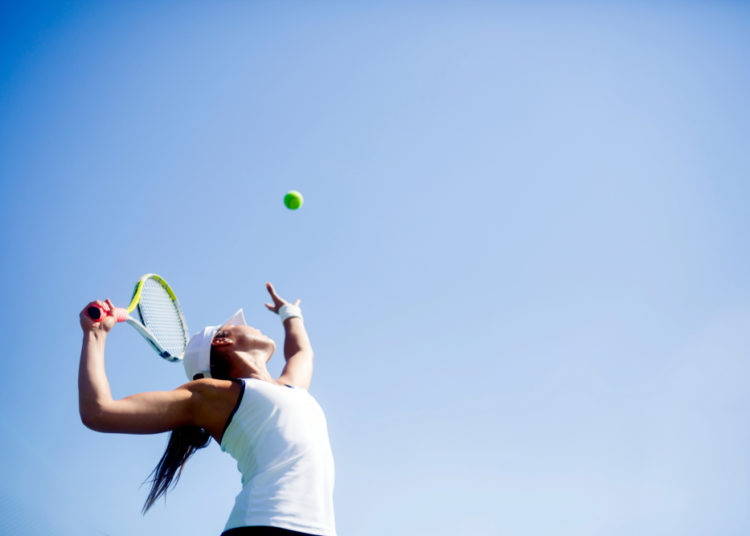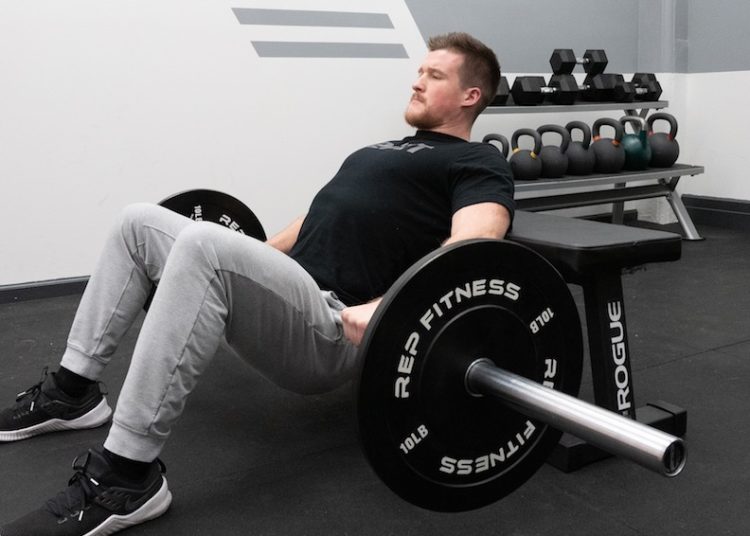Long ago strength training for tennis wasn’t in vogue, even among the professional players.
Even the great John McEnroe (winner of the US Open in 1979, 80, 81, and 84), famously avoided strength training. To keep himself fit, he would just play as many matches as possible.
He got away with this because of his otherworldly talent but now times have changed, and tennis players look more like Serena Williams and Rafael Nadal. If you want an edge, you hit the gym.
If you play tennis or are considering playing, strength training is essential because the attributes needed to play the modern game are developed and enhanced in the weight room.

The Benefits of Strength Training for Tennis Players
Here is what strength training can do for tennis players of all levels and shapes and sizes.
1. Improve Strength
With hard hitting such a huge part of the modern game, having a base of strength is essential. The muscles of the hips, hamstrings, core and the upper body are all involved in ground strokes and serves.
And performing movements in the weight room that use the same motions of the stroke/serve will help improve power and coordination on the court. For example, an overhead med ball slam mimics the motion of the serve and the overhead smash.
[Perfect your form with our guide to the overhead medicine ball slam!]
There are no secrets in the exercises that get you strong. Squats, trap bar deadlifts, carries, and rows are fundamentals.
These exercises aid in providing reactive strength, which is the ability to change quickly from an eccentric to a concentric contraction and their ability to develop maximal forces in minimal time.

With tennis being a dynamic sport will quick changes of direction, players need the strength to do this quickly while remaining injury free.
Furthermore, due to the unilateral nature of tennis, it is important to address muscle imbalances, because only one side of the body is used and opposing sides/muscle groups get under developed.
That’s why unilateral exercises such as single arm rows and split squats/lunges need to play prominent role in a player’s program.
Furthermore, according to Kevin Mullins, a personal trainer at Equinox in Washington D.C, strength training is critical for tennis players because it helps build resiliency in the soft tissues, especially in the tendons and ligaments.
“Tennis is a violent sport full of positive and negative accelerations on hard surfaces in unpredictable patterns,” he says. “Those athletes need the ability to break down those forces in safe manners.”
[See our complete guide to the split squat here!]
2. Improve Power
Power and strength both need to be trained for a tennis player to be complete.
The difference between power and strength is that strength refers to the ability to overcome resistance, while power is the ability to overcome resistance in the shortest period of time. Consider the difference between a squat and a box jump, or a deadlift and a clean: power-based movements are more explosive.
And nothing in the modern game is more important than a powerful serve.
A powerful serve shortens points and demoralizes opponents. It puts the pressure on the other player to do the same and frees the big server to swing away on service returns.
Although advances in the modern racquet have made it easier to hit the ball harder, you still need pop in the upper body and core. This is where strengthening the muscles of the core comes in.
Exercises such as med ball burpees, sit up with med ball pass, side planks, and side planks with a unilateral row all use movement patterns that closely simulate the tennis serve.(1)
The burpee, or the squat thrust if you’re standing up rather than jumping up, trains the transfer of power from the lower to the upper body. the sit up with med ball pass overloads the abdominals concentrically while the side plank variations stabilize the lower and upper body (shoulders and glutes) muscles.
These exercises provide the foundation for a powerful serve.

3. Injury Prevention
The physical demands of the game, the unilateral nature of the sport, and repetitive movements such as the serve, forehand and backhand, can all increase injury risk if the body isn’t strengthened the right way. Targeted strength training exercises will help with injury prevention. (2)
Injuries in the shoulder and elbows are common and need to be addressed in the gym, says Mullins.
Training the muscles of the rotator cuffs and mid-back are critical, but a lot of people overlook the forearms and stress in the biceps and triceps. Quality arm work focused on a full range of motion with adequate volume is critical to long term health and performance.
Exercises such as side lying external rotation, prone horizontal abduction, 90/90 external rotations will help keep the shoulders healthy. And exercises for the elbows (and forearms) include wrist flexion and extension using a dumbbell or a wrist roller.(3)
Furthermore, due to the lateral nature of the game with quick changes of direction, ankle sprains are common.
Training ankle mobility in the warm up with exercises such as ankle mobilizations and strengthening the ankles with lateral walks and the exercise below will help prevent ankle sprains too. (We’ll put all this together in the workouts in the next section.)
4. Enhance Speed/Change of direction
Tennis is a 3D sport with random, explosive events. Thus, training must occur in a 3D way to have the most transfer.
This means extending traditional patterns such as lunges and squats into the frontal/transverse planes and performing drop steps, shuffles, and power are critical says Mullins.
Exercises such as Cossack squats, side lunges, drop lunges, side shuffles, and box jump variations come into play after a strength base is established.
Plyometrics (eccentric loading followed by a concentric contraction) improve explosive movements by improving the power output of the player. Furthermore, being able to absorb force and quickly transfer it results in better and faster movement and changes of direction.
Research agrees: junior tennis players who completed 9 weeks of plyometric training improved fitness characteristics that rely on reactive strength and explosiveness such as, lateral reaction time, 4-meter lateral and forward sprints, and drop jumps.(4)
Sample Strength Workout for Tennis Players
Here’s a sample routine from Kevin Mullins combining the factors just discussed.
Warm up
- Ankle Dorsiflexion/Plantar flexion/Inversion/Eversion mobility
- Self myofascial release: think of using a lacrosse ball and foam roller on your soles, glutes, back, and outer thighs.
- Hip Rockers
- Hip 90’90s
A: Mobility, Speed, Power, Upper Pull
Group one and group two are density circuits. Choose a time frame, say 20 to 30 minutes, and do as many circuits as possible.
The sets and reps you’ll do is dependent on your goal. For example, for strength keep the reps between 4 to 8. If hypertrophy or endurance is the goal, keep reps between 12 to 15 for each exercise.
Do these exercises in a circuit fashion keep the rest between exercises minimal and resting for 1 minute ( or longer) at the end of each circuit.
Group 1
- Trap Bar Deadlifts
- Dumbbell Snatches
- Prone Dumbbell Rows
- Cable Chops
- Alternating Crab Reaches
Group 2
- Supinated Pulldowns
- Hollow Holds
- 3D Dumbbell Lunge and Clean Complex
- Side plank DB Holds
- Band Pull aparts
Conditioning
Tennis Court Call Outs (Imaginary ball-gets).
B: Speed, Shoulders, Core, Glutes
Perform the same warm up described above.
Speed Development
30-yard sprints x 8
Group 1
- Barbell Hip Thrusts
- Cossack Squats
- Cable Face Pulls
- Band Pull aparts
- Seated Cable Row
Group 2
- Goblet Squats with heels elevated
- Glute Bridge Marches
- V-ups or Hollow Holds
- Medicine Ball Chops
- Broad Jumps
Conditioning
20-yard shuttle runs x 5
Plank Position Shoulder taps x 20s (5 rounds)
Wrapping up
Although conditioning plays a huge role in tennis, targeted strength training before, during and after the season makes the player more resilient, less prone to injury and able to smoke the ball past his or her opponent.
Featured image via ESBuka/Shutterstock
References
1. Roetert, E. Paul & Ellenbecker, Todd & Reid, Machar. (2009). Biomechanics of the Tennis Serve: Implications for Strength Training. Strength & Conditioning Journal. 31. 35-40. 10.1519/SSC.0b013e3181af65e1.
2. Clin Sports Med. 2000 Oct;19(4):781-92. Musculoskeletal injuries in the young tennis player. Kibler WB1, Safran MR.
3. Ellenbecker, Todd & Pluim, Babette & Vivier, Stephane & Sniteman, Clay. (2009). Common Injuries in Tennis Players: Exercises to Address Muscular Imbalances and Reduce Injury Risk. Strength & Conditioning Journal. 31. 50-58. 10.1519/SSC.0b013e3181af71cb.
4. J Strength Cond Res. 2008 Jan;22(1):182-91. doi:10.1519/JSC.0b013e31815f57ad. The effects of plyometric, tennis-drills, and combined training on reaction, lateral and linear speed, power, and strength in novice tennis players. Salonikidis K1, Zafeiridis A.
